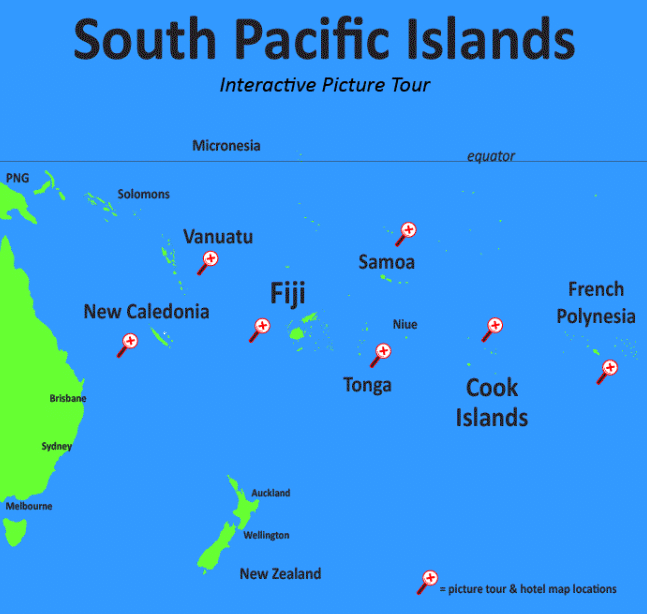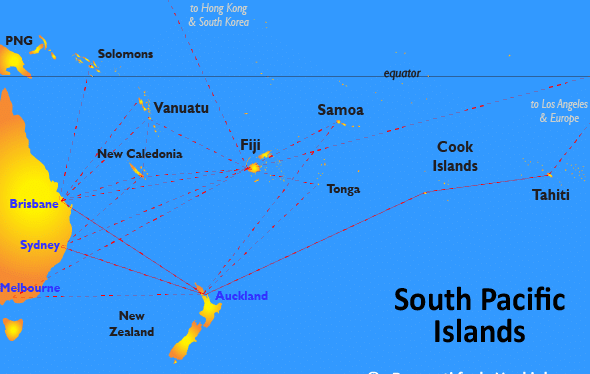
How To Choose A South Pacific Island
South Pacific Islands: The South Pacific confounds even the savviest map buffs with its splatter of dots spread across the world’s biggest ocean. What you can’t tell from a map or even most tourist brochures is that these palm-laden pinpricks are as diverse as the region is vast. While the postcards might look similar, Fiji and Tahiti are not interchangeable or even much alike when it comes to landscapes and culture.
Pacific Islands, island geographic region of the Pacific Ocean. It comprises three ethnographic groupings—Melanesia, Micronesia, and Polynesia—but conventionally excludes the neighboring island continent of Australia, the Asia-related Indonesian, Philippine, and Japanese archipelagoes, and the Ryukyu, Bonin, Volcano, and Kuril island arcs that project seaward from Japan. Neither does the term include the Aleutian chain or such isolated islands of the Pacific Ocean as the Juan Fernández group off the coast of South America. The more inclusive term Oceania, in its broadest definition, encompasses all the foregoing; however, the term is used less strictly in this article to refer to the Pacific Islands as defined above. The Pacific Island region covers more than 300,000 square miles (800,000 square km) of land—of which New Zealand and the island of New Guinea make up approximately nine-tenths—and millions of square miles of ocean. It is a mixture of independent states, associated states, integral parts of non-Pacific Island countries, and dependent states.

What islands make up the South Pacific?
- 01 Fiji & Palau. …
- 02 French Polynesia & Cook Islands. …
- 03 Cook Islands & Australia. …
- 04 Vanuatu & Papua New Guinea. …
- 05 Easter Island & Kiribati. …
- 06 Hawaii & Samoa.
What is the best South Pacific island to visit?
- 1 Bora Bora, French Polynesia. …
- 2 Editor’s Choice Aitutaki, The Cook Islands. …
- 3 The Mamanuca Islands, Fiji. …
- 4 Samoa. …
- 5 Palau. …
- 6 Espiritu Santo, Vanuatu.
Map Of South Pacific Islands

The continental islands, lying southwestward of the Andesite Line, are faulted and folded in mountainous arcs, tend to be higher and larger than those farther east, and have rich soils that support almost every kind of vegetation. Continental islands are generally larger (most notably, the Marianas, New Guinea, the Bismarcks, the Solomons, Vanuatu, Fiji, New Caledonia, and the North and South islands of New Zealand) and have richer mineral-bearing soils than their oceanic counterparts.
The parent lava material of the oceanic type of island is basalt. Oceanic islands are differentiated as high volcanic-based islands, such as Hawaii, or low coral islands and atolls, such as the Marshalls. Most Pacific islands are coral formations, although all of these rest on volcanic or other cores. In the shallow waters of the tropics, both continental and oceanic islands attract coral growth in the form of fringing reefs, partially submerged platforms of consolidated limestone, with coral organisms at the ocean edge feeding on materials carried in by waves and currents. Many islands have been gradually submerged through a combination of sinking, caused by geologic action, and flooding, caused by the melting of ice caps. As islands were flooded, coral growth continued outward, producing barrier reefs farther from the shorelines and separated from them by lagoons.
South Pacific Islands List
The South Pacific is a big place – incredibly vast and blue, covering 11 million square miles stretching from the top of Australia to the Hawaiian Islands. Celebrated by artists and writers, from Paul Gauguin to James Michener, these thousands of tiny coral and volcanic-stone dots are home to fascinating peoples and cultures. Some islands – such as Tahiti and Fiji – are well known, while others not so much. You get a gold star if you’ve even heard of Aitutaki or Yap.
Tourism infrastructure varies by destination, with some islands linked by daily non-stop flights from Los Angeles and others reachable only by a hodgepodge of connections. Most are welcoming to tourists, some with five-star resorts and a roster of water-based activities, while others feature rustic accommodations and cultures that are a bit more unfamiliar with western ways. Divers flock here not only for the abundance of fish species but also for the pristine coral reefs.
While collectively called the South Pacific, these islands are divided into three regions: Polynesia, Melanesia, and Micronesia, each with its own cultural traditions, language variations, and culinary specialties.
Polynesia
This easternmost South Pacific region, which includes Hawaii, counts idyllic Tahiti and mysterious Easter Island among its treasures. Its ocean-going settlers, originally from Southeast Asia, are renowned for their navigation, having survived arduous journeys in dugout canoes as early as 1500 B.C.
French Polynesia (Tahiti)
Comprised of 118 islands, the most celebrated of which is Bora Bora, Tahiti is an independent nation with ties to France. With well- developed tourism on a dozen islands, Tahiti has been luring travelers for five decades with overwater bungalows, French-influenced cuisine, and exotic culture.
The Cook Islands
Lesser-known than neighboring Tahiti, these 15 islands, named for English explorer Captain James Cook and run as a self-governing nation with ties to New Zealand, are home to 19,000 people renowned for their drumming and dancing. Tourists generally visit the main island of Rarotonga and small lagoon-caressed Aitutaki.
Samoa
This group of nine islands was the first in the Pacific to gain independence from western occupation. Upolu is the main island and tourism hub, but life here is still governed by Fa’a Samoa (The Samoan Way), where family and elders are respected and its 362 villages are presided over by 18,000 matai (chiefs).
American Samoa
Marketed as “Where America’s sunsets,” this U.S. territory, with its singsong capital Pago Pago (on main island Tutuila), consists of five volcanic islands totaling just 76 square miles and a population of 65,000. Its tropical rainforests and marine sanctuaries are superb.
Tonga
This island kingdom straddles the western side of the International Dateline (Tongans are first to greet the new day) and consists of 176 islands, 52 inhabited. The present king, His Majesty King George Tupou V, has ruled his nation’s 102,000 people since 2006, residing in the capital, Nuku’alofa, on the main island Tongatapu.
Easter Island (Rapa Nui)
Settled by the Polynesians about 1,500 years ago and discovered by the Dutch (on Easter Sunday in 1722, hence the name), this remote 63-square-mile island is home to about 5,000 people and 800 moai, giant stone statues. Owned by Chile, the island offers rugged beauty and a blend of cultures.
Melanesia
These islands, located west of Polynesia and south of Micronesia – among them Fiji and Papua New Guinea – are known for their many ceremonial rituals and customs, elaborate body tattoos, and wood-carving techniques.
Fiji
Consisting of 333 islands, this welcoming nation of about 85,000 people – all of whom love to shout their exuberant greeting, “Bula!” every chance they get – is known for its luxurious private-island resorts and superb diving. The main island, Viti Levu, home to the international airport at Nadi, is the hub from which tourists fan out to Vanua Levu and resorts in the pristine Yasawa and Mamanuca islands.
Vanuatu
This republic of about 221,000 people in three hours by air from Australia. Its 83 islands are mostly mountainous and are home to several active volcanoes. Vanuatans speak 113 languages, but all celebrate life with a series of rituals and events, making it a fascinating spot to visit. The capital is Port Vila on Efate island.
Papua New Guinea
Adventure-seekers typically have this nation wedged between Australia and Southeast Asia on their must-see list. Covering 182,700 square miles (the eastern half of New Guinea Island and 600 other islands) and home to 5.5 million people (who speak 800 languages – although English is official), it is a prime spot for bird watching and expedition trekking. The capital is Port Moresby.
Micronesia
This northernmost sub-region is comprised of thousands of small (hence the term micro) islands. Best known is the U.S. territory of Guam, but other isles such as Palau and Yap have hidden pleasures (such as incredible dive sites) and eccentric oddities (such as giant stones used as currency).
Guam
This 212-square-mile island (Micronesia’s largest with 175,000 people) may be a U.S. territory, but its unique Chamorro culture and language is a blend of 300 years of Spanish, Micronesian, Asian, and western influences. As Continental Airlines’ South Pacific hub, Guam has excellent airlift and is the region’s melting pot.
South Pacific Islands Cruise
The climate of the Pacific Islands is generally tropical (except in New Zealand, which has a temperate climate), with temperatures, humidity, and rainfall relatively uniform throughout the year. Temperature varies from averages in the low 80s F (about 28 °C) on both Nauru and Kiribati to an average in the low 60s F (about 15 °C) on Norfolk Island, one of the southernmost Pacific Islands. Most vegetation is derived from Indonesia and New Guinea, and its generic variety declines eastward across the Pacific.
Local environmental differences and relative isolation have resulted in the evolution of numerous new endemic species. The introduction of new species from throughout the world has also markedly altered island flora. Only a small proportion of the total land area is arable and, outside New Zealand and Papua New Guinea is devoted mostly to the cultivation of coconut and cassava. Most of the larger islands also support some livestock. As much as two-thirds of the Pacific Islands’ total land area is forested. Most of the islands are poor in mineral resources.
The population is concentrated in Papua New Guinea, New Zealand (which has a majority of people of European descent), Hawaii, Fiji, and the Solomon Islands. Most Pacific Islands are densely populated, and habitation tends to be concentrated along the coasts.
Islands In South Pacific
A chain of some 500 islands in the western Pacific, Palau is recognized by divers-in-the-know as one of the best areas to scuba, thanks to three currents converging in its waters, bringing together some of the most varied aquatic life in the ocean.
Several of Palau’s most popular dive sites are situated around the UNESCO World Heritage-listed Rock Islands (445 sheer limestone islands that dot more than 100,000ha of surrounding waters), including Blue Corner, where feeding sharks, eagle rays, and turtles are all part of the underwater show. Wreck-diving enthusiasts will also be sated, as innumerable wrecks litter the seafloor. And while scuba is undoubtedly the main drawcard here, you can’t leave without donning snorkel gear and exploring Palau’s famed Jellyfish Lake. Unique to the area, a lack of predators has resulted in the resident jellyfish population evolving to the point of having no ability to sting. Taking the plunge with millions of these pulsating, soft-bodied creatures is an extraordinary experience.
Islands In The South Pacific
Infinitely less touristy than Bora Bora, the Cook Islands’ Aitutaki looks across what is billed as the most beautiful lagoon in the world – how’s that for an accolade? Check in to the plush Aitutaki Lagoon Resort & Spa – the only upmarket hotel that looks over the lagoon’s dreamy waters – and spends lazy days soaking in the view from one of the hammocks strung up between palm trees. Action on this romance-sodden isle primarily involves doing, well, nothing, but when you’re looking for more than serenity, you can go on an organized fishing or scuba trip, or take one of the many cruises that explore the lagoon’s magical sandy islets. Whatever you do, the island’s mash-up of romance, beauty, and luxury is a winning combination.
Even after European settlement in the 19th century, this Cook Islands hub has successfully retained its Polynesian heritage. Today, there are no traffic lights, no McDonald’s, and no buildings taller than a coconut tree. Indeed, indigenous culture is celebrated everywhere through dance, music, art, and festivals commemorating the region’s colorful past. The purpose-built
Te Vara Nui cultural village is the best place for visitors to glean
an understanding of this local culture.
Map Of South Pacific Ocean Islands
Eye-popping blue waters, palm trees, powdery beaches, and perfect sunny days probably spring to mind when you dream about the fabled islands of the South Pacific. Some of the most beautiful islands in the world lie in this beguiling region, but each of these tropical beauties offers something different. Polynesian island chains like Samoa, the Cook Islands, and French Polynesia offer luminous aqua lagoons, fish-rich coral reefs, and dazzling beaches with silky-soft sands. Melanesian island chains like Fiji, Vanuatu, and New Caledonia offer a similar brand of natural beauty, but with their own distinct cultures. Palau is a topographic wonderland above and below water, and cultural and archeological attractions are a top draw in destinations like enigmatic Easter Island. From some of the best islands in Fiji to eco-friendly destinations in Australia, the South Pacific offers the perfect paradise to match your tropical fantasies.
Cloaked in green and encircling an impossibly radiant turquoise lagoon, Bora Bora is the beauty queen of the South Pacific. Glimpsed from afar, the lush peaks of Mount Otemanu and Mount Pahia perk up out of the sea, with arms outstretched as if to welcome you into their seductive embrace. Adventures here cover both land and sea. You can explore the lagoon and its tiny islets or motus on cruises, which often include the opportunity to snorkel with sharks and rays, and you can hike a web of trails up jungly hillsides to survey all the beauty. Top it all off with mouthwatering French-inspired food and romantic resorts, and you have the ultimate honeymoon escape. Both the fancy Four Seasons Resort Bora Bora and the InterContinental Resort & Thalasso Spa offer the island’s famous over-the-water bungalows right on the ravishing lagoon.
